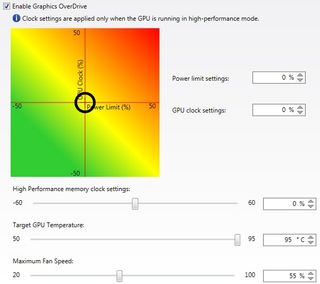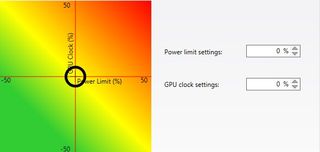Radeon R9 290X Review: AMD's Back In Ultra-High-End Gaming
After eight months of watching Nvidia go uncontested in the ultra-high-end graphics market, AMD has a new GPU based on existing technology that promises to challenge the top position. It gets mighty loud at times, but you can't ignore the R9 290X's price.
Overclocking: PowerTune Changes Things
Because power, clock rate, fan speed, and temperature are all so interdependent, overclocking is not as simple as setting a frequency. In fact, even running at stock settings isn’t that easy. As we saw on the previous page, you'll start with great clock rates and taper off to something lower over time.
Catalyst Control Center: OverDrive, Updated
Changes to the Catalyst Control Center affect the performance and power consumption of AMD's Radeon R9 290X. As you can see, the OverDrive applet looks a lot different from what you're used to. There's that heat map, to begin, which defines how much power and clock rate (as percentages) to increase or decrease compared to AMD's stock configuration.

“Over Limit” instead of Overclocking
Overclocking in the traditional sense of the word doesn't really make sense with this board. Under normal conditions, and faced with a full load, the R9 290X already isn't able to sustain the "up to 1 GHz" specified by AMD. You saw that on the previous page. So, depending on the game or application you're running, Hawaii needs an extra nudge from its power limiter to run at higher speeds (and then, only if you have the cooling to allow this).
Here's a look at AMD's original settings:

Increasing the power limit by 25 percent pushes consumption up to (and briefly beyond) the 300 W available from one six-pin auxiliary connector, one eight-pin lead, and the PCI Express slot. We didn't want to risk going much higher than that for our review. Our peak power consumption measurements do show that there’s some additional headroom, though, at this point it's all conjecture since we weren't getting any performance increase attributable to a higher power limit or fan speed setting. Too-high temperatures are to blame for this.
So, how do we lower them?
Fan RPM and Target Temperature
You want to bring your temperature target down, rather than increasing it, to trigger more aggressive cooling. Here’s the default setting:
Stay on the Cutting Edge
Join the experts who read Tom's Hardware for the inside track on enthusiast PC tech news — and have for over 25 years. We'll send breaking news and in-depth reviews of CPUs, GPUs, AI, maker hardware and more straight to your inbox.

As we now know, you can no longer specify a fan speed in RPM. Instead, a maximum “up to” percentage is selected, which represents the highest duty cycle AMD's fan will spin. Again, the Quiet firmware defaults to 40%, while Uber mode stops at 55%.


You cannot override those ceilings by simply moving the slider all the way over to 100% and enjoying lower temperatures. Since AMD's 95-degree default limit can typically be maintained somewhere between 40 and 50%, you need to change the target temperature, too.

Set up like this, you're more likely to hear the R9 290X's fan hit the gas and take off. Depending on your power limit setting, it's possible to get this card's cooler spinning at 95% under full load. Those settings are the only way we were able to hit our peak power consumption measurements.
As with traditional overclocking, increasing the R9 290X's power limit alters AMD's specification. Company representatives assure us that Hawaii is meant to be used at 95 degrees, but that's already really hot. We're not sure yet how pushing power even higher will affect the GPU's reliability. Take a cautious approach under the enthusiast community has more time to experiment (you'd better believe Nvidia is going to figure out what it takes to make this thing pop as soon as it can).
Current page: Overclocking: PowerTune Changes Things
Prev Page PowerTune: Balancing Performance And Acoustics Next Page The Radeon R9 290X-
beta212 That's incredible. Especially at high res, I wonder how they do it. But the low price alone is enough to blow the competition away. Seriously think about it, it's around half the price for higher performance!Reply
- AMD: We're not aiming for the ultra high end.
I think Nvidia just got trolled. -
slomo4sho Great price point. This card has already broken world records just a few hours after release!Reply
-
esrever 2 of these for 4k looks amazing but Im a little disappointed by the power consumption when you crank up performance.Reply -
aznguy0028 I was thinking about hopping on the 7970ghz when it's on sale, but after seeing this, it's time to break apart the piggy bank for the 290x, what value!Reply -
Benthon Like the conclusion said, you just can't argue about aesthetics and thermals at this price point/performance. Well done AMD, lets see team green's response! Go consumer!Reply -
Shankovich Wow, and it's pegged at 73% too. Even if nVidia's "780ti" beats the 290X, it probably won't beat a 290X running at full power. And if mantle does make some big performance boosts, nVidia is going to be in a really tight spot. Looking forward to what they'll do. In the mean time, loving this competition! We all win in the end.Reply -
anxiousinfusion Wait the 290 X... X? is going to be $550?! Forgive me, padre for I have sinned.Reply
Most Popular

